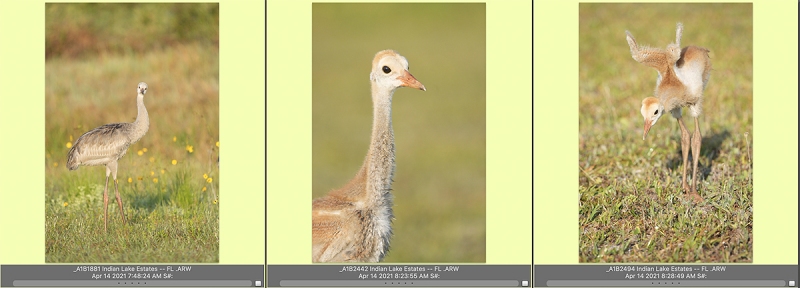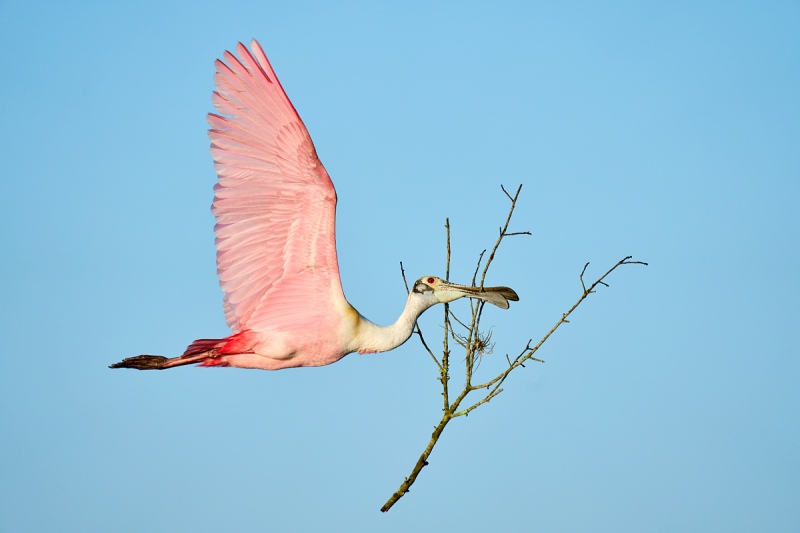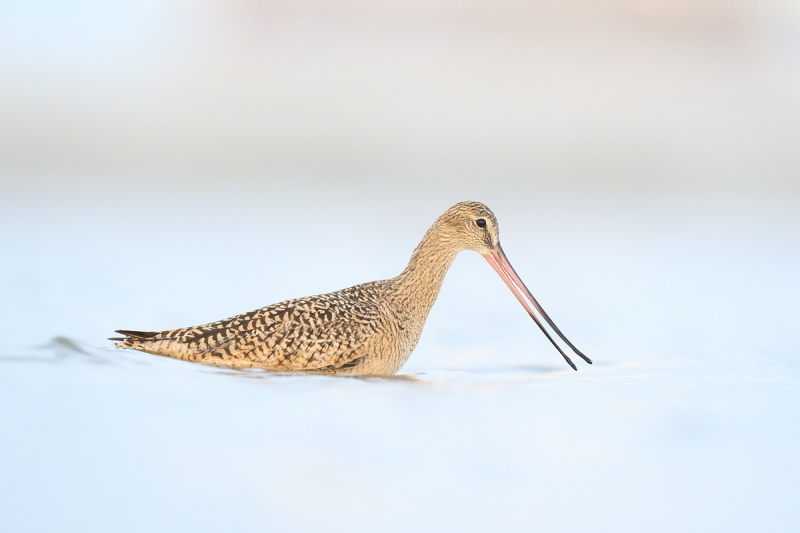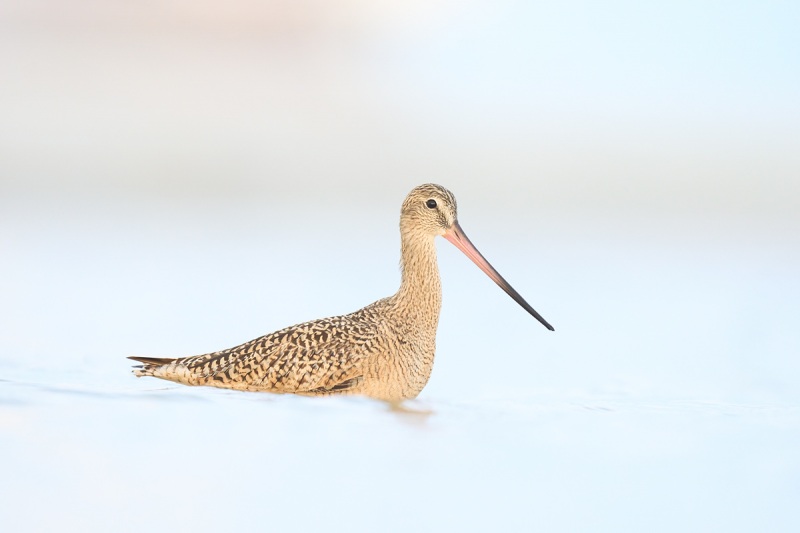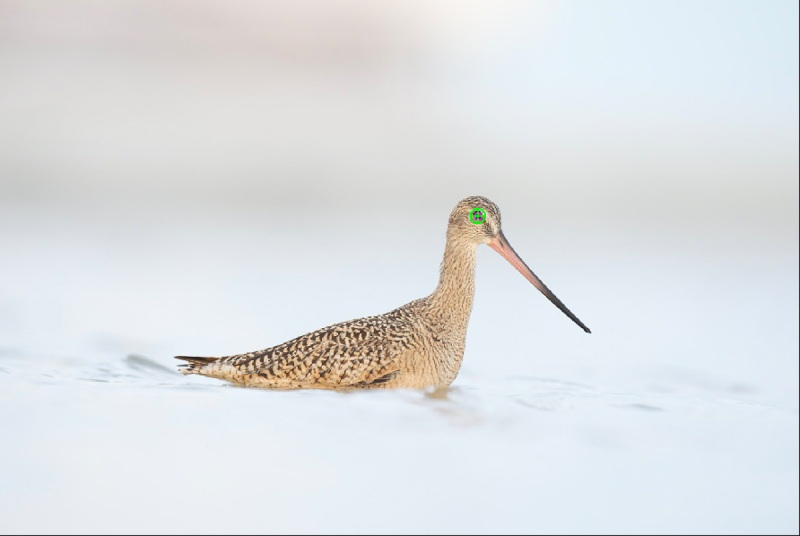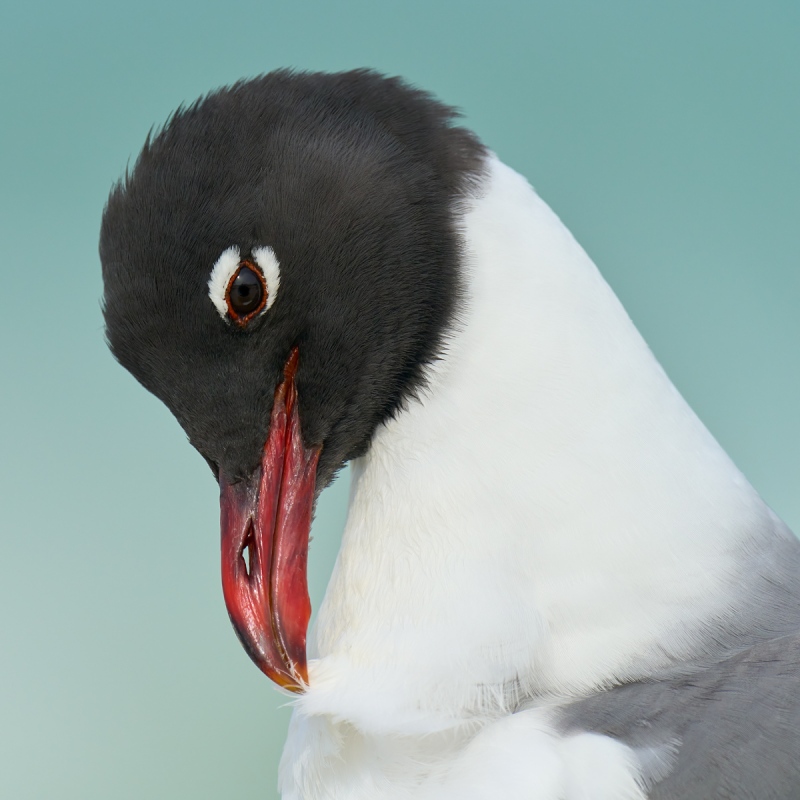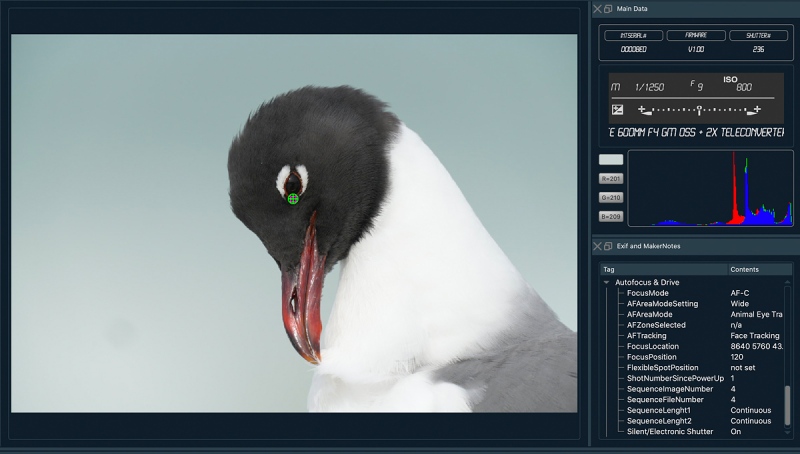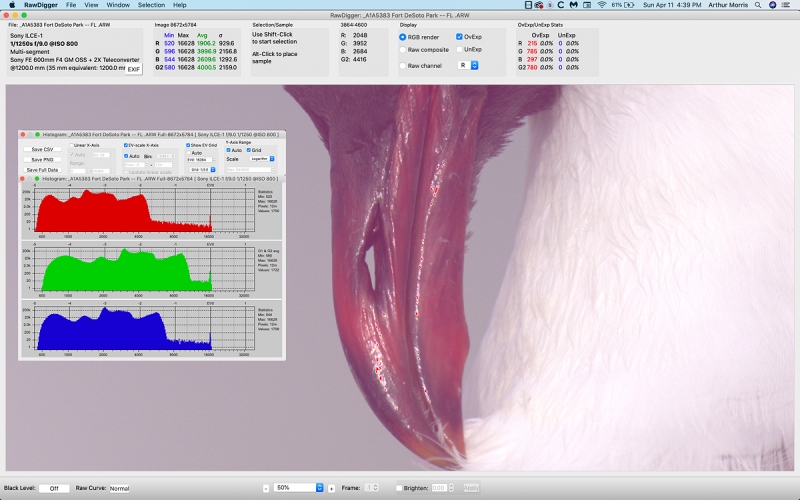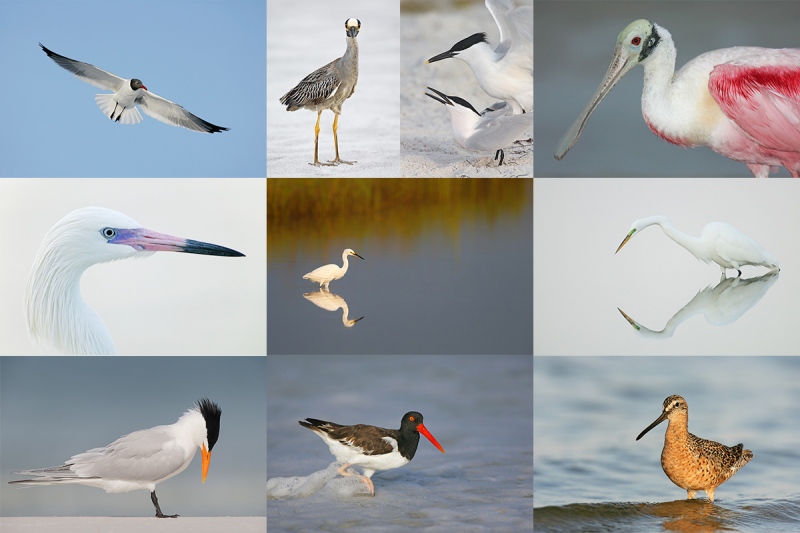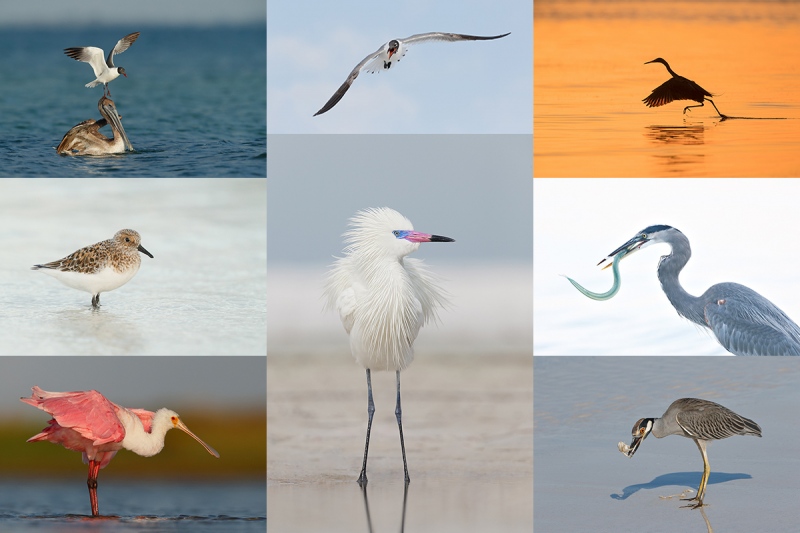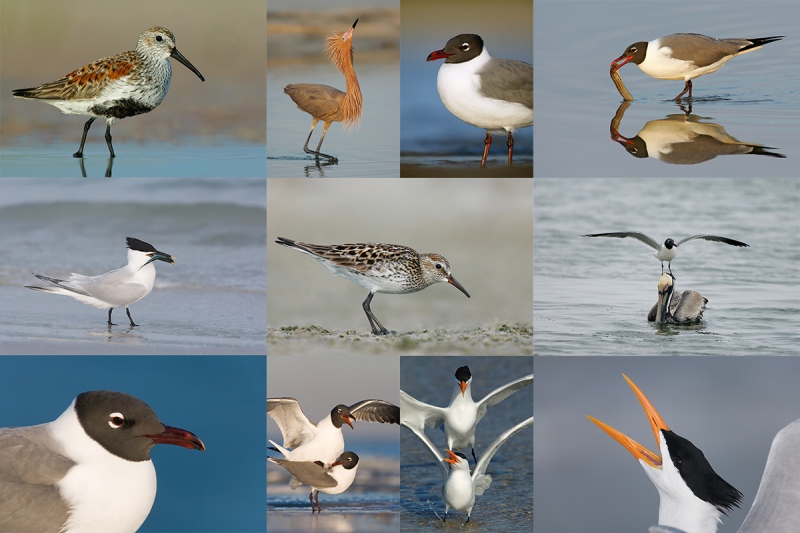April 14th, 2021
|
|
|
Click on the image to see a larger version.
Wednesday morning all with the hand held 200-600 G and the Sony Alpha a1
|
This Just In!
I enjoyed a great session down by the lake this morning. First, I found the single surviving colt feeding in tickseed blossoms along the lakeshore, and then I found the two now-large and still silly-tame chicks. The weather is looking good for the next few days especially Friday. If you would like to join me for a morning session with the cranes, please get in touch via e-mail or by phone or message to 863-221-2372 to discuss rates (inexpensive) and set up a schedule.
What’s Up?
Monte Brown and John Johnson and I went to Stick Marsh early on Tuesday. It was good but not great; the winds, out of the northwest, were a bit stronger than had been forecast. That said, Monte and John did have some great chances with incoming spoonbills as is par for the course at this location. John headed home to Naples and Monte came back to ILE with me for a smoked salmon brunch and to pick up his truck.
After checking out the 10-day weather forecast for Bismarck, ND I cancelled my Prairie Chicken trip. I usually do not shy away from photographing in bad weather but these tidbits caught my attention: temps in the low 20s with strong winds from the northwest. My pool is very warm right now … And inviting.
I headed down to the lake at sunset. The wind was perfect but there were no birds (other than a fly-by Boat-tailed Grackle or two.)
Thanks to the many who commented on the Marbled Godwit swimming in heaven images featured in yesterday’s blog post. My goal as always was to get folks seeing and thinking. I will share my thoughts tomorrow.
Today is Wednesday 14 April. The forecast is for clear skies with gentle winds from the east. Now that I do not have to pack for a cold weather trip today, I will be heading down to the lake early. Wherever you are, and whatever you are doing, I hope that you have a great day.
This blog post took about ninety minutes to prepare and makes 112 consecutive days with a new one. Please remember to use my B&H affiliate links or to save money at Bedfords by using the BIRDSASART discount code at checkout. Doing either often earns you free guides or discounts. And doing so always earns my great appreciation.
Sony Alpha a1 AF Magic …
The AF system of the a1 — set up as detailed in e-mails to the Sony Alpha a1 Info & Updates group, continues to amaze me. Early on, there was lots of discussion within the group with many preferring multiple back button approaches. For me a simple shutter button approach with the right AF settings that yield 99% sharp-on-the-eye images is best. By far. It is super-simple and mega-effective. Note: info on the program that I use to ascertain SONY AF point information is detailed in one of the SONY Alpha a1 Set-up and Info Group e-mails. I plan on making that information available here soon for all SONY camera users. You guessed it; I am working on a guide. 🙂
SONY Alpha a1 Set-up and Info Group
The SONY Alpha a1 Set-up and Info Group is going great guns as folks chime in with thoughtful questions and experience-based advice. We are now up to an astounding 35 folks. Early on, we discussed the myriad AF options. I gave my opinion as to the best one for flight and general bird photography. More recently, we have been in contact with folks at SONY sharing our thoughts, experiences, and frustrations with the EVF blackout problem.
All who purchased their Alpha a1 bodies via a BAA affiliate link will receive a free subscription to the Sony Alpha a1 Set-Up and Info Updates after shooting me their receipts via e-mail. This same service may be purchased by anyone with an a1 body via a $150.00 PayPal sent to birdsasart@verizon.net indicating payment for Alpha a1 Info Updates. Alternatively, they can call Jim weekday afternoons at 1-863-692-0906 to pay via credit card. New members will receive composite e-mails that summarize all previous discussions.
The BAA Used Gear Page
The Used Gear page continues to be very active. The BAA Used Gear Page is the place to sell your used photographic equipment. We will help you to get your gear sold quickly for 20 to 60% or more than what the big guys are offering … Doubt me? Check out the Recent Sales list for the past eleven months at the bottom of the page.
Canon EOS-1DX Mark II Professional Digital Camera Body (with great extras!)
IPT veteran William Wingfield is offering a Canon EOS-1DX Mark II camera in near-mint condition with lots of extras for $2398.00. The sale includes the front lens cap, one extra battery, the battery charger, the original box, the manual, three CFast cards (two @ 128GB and 1@ 64GB), the CFast reader, One @ 64 GB CF card, and insured ground shipping via major courier to lower-48 US addresses only. Your item will not ship until your check clears unless other arrangements are made.
Please contact Bill via e-mail or by phone at 1-843-729-6670 (Eastern time zone).
The 1DX Mark II is a rugged, blazingly fast Canon professional digital camera body. It features an amazing AF system and high quality image files with great dynamic range. When he used Canon, it was the first choice of Arash Hazeghi, one of the world’s premier birds-in-flight photographers. This body is still in production and currently sells new for $4,499.00. Save a very sweet $2101.00 by grabbing Bill’s dSLR ASAP. artie
Canon EOS-5DS R dSLR (with extras)
Sold first day of listing
William Wingfield is offering a Canon EOS-5DSR camera in near-mint condition for $799.00.The sale includes the front lens cap, one extra battery, the charger, the original box, the manual, 3 Compact Flash cards (32GB, 64GB, 128GB), and insured ground shipping via major courier to lower-48 US addresses only. Your item will not ship until your check clears unless other arrangements are made.
Please contact Bill via e-mail or by phone at 1-843-729-6670 (Eastern time zone).
Though it is well-noted as a superb camera for landscapes and macro, I used this fine, 50.3 MP body to make lots of great bird photographs when I shot Canon. The 5DS R currently sells new for $1499.00 and is back-ordered in most places. Grab Bill’s 5DS R and save a very handsome $700.00. artie
Canon 100-400mm f/4.5-5.6L IS II USM Lens
William Wingfield is offering a Canon 100-400mm f/4.5-5.6L IS II USM lens in like-new condition for $1499.00. The sale includes the front and rear lens caps, the tough fabric lens case, the original box, and insured ground shipping via major courier to lower-48 US addresses only. Your item will not ship until your check clears unless other arrangements are made.
Please contact Bill via e-mail or by phone at 1-843-729-6670 (Eastern time zone).
This incredibly versatile zoom lens — with its amazing .98 meter close focus — was my favorite Canon telephoto zoom lens ever. By far. It is great for tight portraits, birds in flight, quasi-macro stuff, and lots more. It sells new for $2399.00 so you can save some hard cash by grabbing Bill’s pretty much new lens now. artie
Canon EF Extender 1.4X III (teleconverter)
Sold first day of listing
William Wingfield is offering a Canon EF Extender 1.4X III (teleconverter) in like-new condition for $249.00. The sale includes the front and rear caps, the lens pouch, a LensCoat, and insured ground shipping via major courier to lower-48 US addresses only. Your item will not ship until your check clears unless other arrangements are made.
Please contact Bill via e-mail or by phone at 1-843-729-6670 (Eastern time zone).
As regular readers know, teleconverters are so important to what I do with my bird photography that I always travel with two back-up 1.4X TC and one extra 2X TC. This sells new for $429 without the LensCoat! artie
Canon EF Extender 2X III (teleconverter)
Sold first day of listing
William Wingfield is offering a Canon EF Extender 2X III (teleconverter) in like-new condition for $249.00. The sale includes the front and rear caps, the lens pouch, a LensCoat, and insured ground shipping via major courier to lower-48 US addresses only. Your item will not ship until your check clears unless other arrangements are made.
Please contact Bill via e-mail or by phone at 1-843-729-6670 (Eastern time zone).
As regular readers know, teleconverters are so important to what I do with my bird photography that I always travel with two back-up 1.4X TC and one extra 2X TC. This sells new for $429 without the LensCoat! artie
|
|
|
This image was created on 13 April 2021 at Stick Marsh. I used the hand held Sony FE 200-600mm f/5.6-6.3 G OSS lens (at 600mm) and The One, the Sony Alpha 1 Mirrorless digital camera.
ISO 2500. Exposure determined via Zebras with ISO on the rear dial: 1/3200 sec. at f/6.3 (wide open) in Manual mode. AWB at 7:50am on a sunny morning.
Wide/AF-C was active at the moment of exposure and nailed the focus. Click on the image to see a larger version.
Roseate Spoonbill with stick for nest
|
Sometimes You Just Have to Stick With It …
Trying for something different, I had walked over to Spot L (as per the annotated Stick Marsh Site Guide map). Creating images of spoonbills carrying nesting material is always difficult at Stick Marsh because 99% of the birds are angling away from you as they return to the rookery.
This bird doubly surprised me:
- 1- it was flying much closer to the shore (and to me!) than all of the other birds.
- 2- it was flying parallel to my position (rather than angling away).
The lens had been zoomed to 600mm while working (and expecting) more distant subjects, when I spotted this bird out of the corner of my left eye on an unexpectedly good flight path. I quickly raised the lens and fired off about ten frames knowing that I should have zoomed out. But my brain had not been set up for zooming out … A quick glance at the images revealed a few poor wing positions, lots of clipped wings, and the bottom end of the stick clipped. In retrospect, I knew that I had not panned very smoothly. But I had kept firing.
As I was editing the series, I had tagged two images to keep thinking that I might be able piece together a single good image from those. I was quite happy when I came across today’s featured image. I used the Divide and Conquer Technique to trim the branch. And I did some neat Eye Doctor work as well.
At Stick Marsh, I have been seeing this seemingly awkward flight pose often when the birds are carrying either very large sticks or sticks that are too heavy for them. As seen above, they raise their heads and rotate them, apparently to facilitate carrying the big sticks. As for me, I am glad that I stuck with it.
The Stick Marsh Site Guide Subscription Service
The Site Guide Subscription Service is a new concept. I e-mailed the first issue last week: Stick Marsh Site Guide e-Mail #1: The Basics. The Basics e-mail includes specific directions to the site, and a map of the rookery area with specific instructions and wind, weather, and where-to-be advice. I e-mailed the second installment recently. In it, I shared several new shooting locations and strategies. I will be sending e-mail #3 on Monday with lots more to come.
To sign up for the Stick Marsh Site Guide Subscription Service, call Jim in the office weekday afternoons at 863-692-0906 with your credit card in hand or send a PayPal for the $100.00 to us at birdsasart@verizon.net. Please be sure to include the words Stick Marsh with your PayPal. At some point, we will get this item in the BAA Online Store.
I fully understand that you can go to Google Maps, find the Stick Marsh, visit, and likely make some good or great images. You might think, I can do fine just without artie’s advice. But you will do a whole lot better with it. The annotated map alone is worth the price of admission.
Typos
With all blog posts, feel free to e-mail or to leave a comment regarding any typos or errors.
April 13th, 2021 A Tough Question
If you had to delete one of today’s two featured images, each admittedly superb, which one would you put in the trash? Why? Comparing the strengths and weaknesses (if any) of each image might reveal the answer. Or not. One thing is for sure, comparing the merits of these two images will be a challenge that gets you thinking.
What’s Up?
Monte Brown joined John Johnson and me on Monday morning at Fort DeSoto. Again, the weather forecast was way off, much to our benefit. The original forecast was for clear skies with northwest winds — death for bird photography. Then it changed to light rain with northwest winds — not too good for bird photography. What we got was cloudy followed by intermittent clearing with west/southwest winds. That turned out to be pretty darned good for bird photography! We had an absolutely fantastic morning.
You will be seeing lots more images from that session here fairly soon, along with the tales behind them. I am head-over-heels in love with both of today’s featured images.
On Monday afternoon, we ended the IPT a day early and drove over to ILE for a pool-deck, rib-eye steaks on the grill, big salad dinner and some more fine wine.
Today is Tuesday 13 April 2021. The three of us will be heading over to Stick Marsh early. The forecast if for perfectly clear skies with little to no wind. The three of us are very excited. Wherever you are, and whatever you are doing, I hope that you have a great day.
This blog post took about ninety minutes to prepare and makes 111 consecutive days with a new one. Please remember to use my B&H affiliate links or to save money at Bedfords by using the BIRDSASART discount code at checkout. Doing either often earns you free guides or discounts. And doing so always earns my great appreciation.
Camera User’s Guide Note
If you should have but did not receive a link to the final versions of the SONY Camera User’s e-guide or the link to the final version of the BAA R5 Camera User’s e-guide, please let us know via e-mail.
Please Remember
With income from IPTs now at zero, please, if you enjoy and learn from the blog, remember to use one of my two affiliate programs when purchasing new gear. Doing so just might make it possible for me to avoid having to try to get a job as a Walmart greeter and will not cost you a single penny more. And if you use Bedfords and remember to enter the BIRDSASART code at checkout, you will save 3% on every order and enjoy free second-day air shipping. In these crazy times — I am out at least forty to sixty thousand dollars so far due to COVID 19 (with lots more to come) — remembering to use my B&H link or to shop at Bedfords will help me out a ton and be greatly appreciated. Overseas folks who cannot order from the US because of import fees, duties, and taxes, are invited to help out by clicking here to leave a blog thank you gift if they see fit.
New and Better Bedfords Discount Policy!
You can now save 3% on all of your Bedfords photo gear purchases by entering the BIRDSASART coupon code at checkout. Your discount will be applied to your pre-tax total. In addition, by using the code you will get 2nd day air shipping via Fed Ex.
Grab a Nikon AF-S Teleconverter TC-14E III and save $14.99. Purchase a Canon EOS R5 and your discount will be $116.97. Purchase a Sony FE 600mm f/4 GM OSS lens and save a remarkable $389.94! Your Bedford’s purchase no longer needs to be greater than $1,000.00 for you to receive a discount. The more you spend, the more you save.
Money Saving Reminder
Many have learned that if you need a hot photo item that is out of stock at B&H and would enjoy free second-day air shipping, your best bet is to click here, place an order with Bedfords, and enter the coupon code BIRDSASART at checkout. If an item is out of stock, contact Steve Elkins via e-mail or on his cell phone at (479) 381-2592 (Central time). Be sure to mention the BIRDSASART coupon code and use it for your online order to save 3% and enjoy free 2nd-day air shipping. Steve has been great at getting folks the hot items that are out of stock at B&H and everywhere else. The wait lists at the big stores can be a year or longer for the hard to get items. Steve will surely get you your gear long before that. For the past year, he has been helping BAA Blog folks get their hands on items like the SONY a9 ii, the SONY 200-600 G OSS lens, the Canon EOS R5, the Canon RF 100-500mm lens, and the Nikon 500mm PF. Steve is personable, helpful, and eager to please.


Gear Questions and Advice
Too many folks attending BAA IPTs (remember those?) and dozens of photographers whom I see in the field and on BPN, are–out of ignorance–using the wrong gear especially when it comes to tripods and more especially, tripod heads… Please know that I am always glad to answer your gear questions via e-mail. Those questions might deal with systems, camera bodies, accessories, and/or lens choices and decisions.
|
|
|
This image was created on 12 April 2021 on the first DeSoto IPT. I used the Sony FE 600mm f/4 GM OSS lens (with the lens foot resting on the ground) and The One, the Sony Alpha 1 Mirrorless digital camera. ISO 2500. Exposure determined via Zebras with ISO on the rear dial: 1/500 sec. at f/4.5 (stopped down 1/3-stop; should have been wide open) in Manual mode. AWB at 7:36:56am on a still, cloudy morning.
Wide/AF-C was active at the moment of exposure and performed perfectly. Click on the image to see a larger version.
Image #1: Marbled Godwit foraging while swimming
|
Enthralled With the Super-low Perspectives …
I have always loved getting down and dirty and flat on my stomach photographing shorebirds. With age, getting down is not too bad; getting up is a bit harder. Arching ones back is a problem for some including me. For today’s two featured images, created while I was seated on the wet sand, I placed the lens foot on the ground and tilted out the rear screen. This afforded me the super-low perspective that I love so dearly. Without having to lie down in the wet sand.
|
|
|
This image was created on 12 April 2021 on the first DeSoto IPT. I used the Sony FE 600mm f/4 GM OSS lens (with the lens foot resting on the ground) and The One, the Sony Alpha 1 Mirrorless digital camera. ISO 2500. Exposure determined via Zebras with ISO on the rear dial: 1/500 sec. at f/4.5 (stopped down 1/3-stop; should have been wide open) in Manual mode. AWB at 7:36:58am on a still, cloudy morning.
Wide/AF-C was active at the moment of exposure and performed perfectly. Click on the image to see a larger version.
Image #2: Marbled Godwit swimming
|
The Plusses and Minuses of Using the Rear Screen at Ground Level …
The Plusses
- 1- The super-low perspective produces creamy/dreamy backgrounds (especially at f/4!)
- 2- Photographs created at the subject’s eye level are decidedly more intimate than images made from higher perspectives.
The Minuses
- 1- Even with the level on the rear screen active and your reading glasses on (mine were safely in the car when I made this image), it is a challenge for most folks to level the image. And when you are panning along with a moving subject, keeping the image level even more of a challenge. Next time I will bring my Panning Ground Pod.
- 2- Without having your eye to the viewfinder, you are working somewhat blind. It is difficult to determine the subject-to-sensor-plane orientation and even more difficult to note the head angle.
- 3- Simply finding the subject is far more difficult than it is when working through the viewfinder, and once you find the bird with your long lens, framing it properly can be a huge challenge. Both of today’s images needed small crops for the rear (and from above and/or below), to move the bird back a bit in the frame.
- 4-Again, without your eye to the viewfinder, you must have complete faith in your camera body’s AF system. If it does not perform, all of your effort will be for naught. Note: when looking through the viewfinder, you can see the AF point or points at work … That is not the case when using the rear screen.
5- You will get sand on your lens, the lens foot, the lens hood, and on you camera body. (The same would be true if you were lying prone, flat on your belly, looking through the viewfinder …) That is why you always have a soft paintbrush with you in the field.
So what is the solution? Do your best and make lots of images; the shotgun approach can yield amazingly beautiful dividends (as it did in this situation). And the Sony Alpha 1 Mirrorless digital camera’s 30 frames per second Drive Mode is a huge plus in pretty much all situations where the subject is moving.
Note: though there were two godwits swimming along, I am sure — based on some distinctive plumage markings — that the bird in both images is the same individual.
|
|
Image #2A: AF Point for one of the Marbled Godwit swimming images
|
What Can I Say?
My faith in the AF system (set up properly as detailed in the SONY Alpha a1 Set-up and Info Group e-Mail #1), was completely justified as it nailed the focus in every frame of the 76-image sequence.
Sony Alpha a1 AF Magic …
The AF system of the a1 — set up as detailed in e-mails to the Sony Alpha a1 Info & Updates group, continues to amaze me. Early on, there was lots of discussion within the group with many preferring multiple back button approaches. For me a simple shutter button approach with the right AF settings that yield 99% sharp-on-the-eye images is best. By far. It is super-simple and mega-effective. Note: info on the program that I use to ascertain SONY AF point information is detailed in one of the SONY Alpha a1 Set-up and Info Group e-mails. I plan on making that information available here soon for all SONY camera users. You guessed it; I am working on a guide. 🙂
SONY Alpha a1 Set-up and Info Group
The SONY Alpha a1 Set-up and Info Group is going great guns as folks chime in with thoughtful questions and experience-based advice. We are now up to an astounding 35 folks. Early on, we discussed the myriad AF options. I gave my opinion as to the best one for flight and general bird photography. More recently, we have been in contact with folks at SONY sharing our thoughts, experiences, and frustrations with the EVF blackout problem.
All who purchased their Alpha a1 bodies via a BAA affiliate link will receive a free subscription to the Sony Alpha a1 Set-Up and Info Updates after shooting me their receipts via e-mail. This same service may be purchased by anyone with an a1 body via a $150.00 PayPal sent to birdsasart@verizon.net indicating payment for Alpha a1 Info Updates. Alternatively, they can call Jim weekday afternoons at 1-863-692-0906 to pay via credit card. New members will receive composite e-mails that summarize all previous discussions.
The Fort DeSoto Site Guide
Though a bit long in the tooth (like me), the Fort DeSoto Site Guide will get you to my two favorite morning spots. John Johnson and I killed at DeSoto for three straight mornings.
Typos
With all blog posts, feel free to e-mail or to leave a comment regarding any typos or errors.
April 12th, 2021 What’s Up?
Thanks to the very few folks who commented on their favorites in the last two blog posts. They included Michael Shaw, Elinor Osborne, James Saxon, David Policansky, and Paul Campbell. And not a single person commented on the Willet video. You gotta love it!
The forecast for Sunday morning was dire; there was a 76% chance of severe thunderstorms in St. Pete. John Johnson and I headed to Desoto under clear skies. With the wind from the southwest and the sun rising in the southeast and then moving to the south, we had the birds 90 degrees to the light. That is very good for bird photography, unlike clear skies and NW winds in the morning … We enjoyed 90 minutes of lovely light until some thin clouds moved in. The cloudy-bright conditions were fabulous. All in all we had our second straight great morning session.
Then Armageddon arrived. With a vengeance. The house shook, lightning struck, and the streets flooded. As did the campground at Fort DeSoto; good friend Monte Brown — visiting from Indiana — was unable to get his fifth-wheel trailer into his spot for several hours.
With pouring rain all afternoon and 5G internet in our AirBnB, I got a ton of work done. I sent out a link to the SONY Camera User’s e-guide to all who earned or purchased it. And I sent out the final version of the BAA R5 Camera User’s e-guide, again, to all who earned or purchased it. Jim will be sending out the last of the R5 guides on Monday. If you should have received a link to your updated Camera User’s Guide and did not, please let me know via e-mail.
John and I stayed in and napped and worked on images.
Today is Monday 12 April 2021. I just finished sending out the eighth SONY Alpha a1 Set-up and Info Group e-mail and the fourth Stick Marsh Site Guide e-mail. The forecast for the morning is for partly-cloudy skies with drizzle early then clearing with a light wind from the northwest. It will likely be a challenging morning. But I have a plan. Monte will be joining us. Wherever you are, and whatever you are doing, I hope that you have a great day.
This blog post took more than an hour to prepare and makes 110 consecutive days with a new one. Please remember to use my B&H affiliate links or to save money at Bedfords by using the BIRDSASART discount code at checkout. Doing either often earns you free guides or discounts. And doing so always earns my great appreciation.
Please Remember
With income from IPTs now at zero, please, if you enjoy and learn from the blog, remember to use one of my two affiliate programs when purchasing new gear. Doing so just might make it possible for me to avoid having to try to get a job as a Walmart greeter and will not cost you a single penny more. And if you use Bedfords and remember to enter the BIRDSASART code at checkout, you will save 3% on every order and enjoy free second-day air shipping. In these crazy times — I am out at least forty to sixty thousand dollars so far due to COVID 19 (with lots more to come) — remembering to use my B&H link or to shop at Bedfords will help me out a ton and be greatly appreciated. Overseas folks who cannot order from the US because of import fees, duties, and taxes, are invited to help out by clicking here to leave a blog thank you gift if they see fit.
New and Better Bedfords Discount Policy!
You can now save 3% on all of your Bedfords photo gear purchases by entering the BIRDSASART coupon code at checkout. Your discount will be applied to your pre-tax total. In addition, by using the code you will get 2nd day air shipping via Fed Ex.
Grab a Nikon AF-S Teleconverter TC-14E III and save $14.99. Purchase a Canon EOS R5 and your discount will be $116.97. Purchase a Sony FE 600mm f/4 GM OSS lens and save a remarkable $389.94! Your Bedford’s purchase no longer needs to be greater than $1,000.00 for you to receive a discount. The more you spend, the more you save.
Money Saving Reminder
Many have learned that if you need a hot photo item that is out of stock at B&H and would enjoy free second-day air shipping, your best bet is to click here, place an order with Bedfords, and enter the coupon code BIRDSASART at checkout. If an item is out of stock, contact Steve Elkins via e-mail or on his cell phone at (479) 381-2592 (Central time). Be sure to mention the BIRDSASART coupon code and use it for your online order to save 3% and enjoy free 2nd-day air shipping. Steve has been great at getting folks the hot items that are out of stock at B&H and everywhere else. The wait lists at the big stores can be a year or longer for the hard to get items. Steve will surely get you your gear long before that. For the past year, he has been helping BAA Blog folks get their hands on items like the SONY a9 ii, the SONY 200-600 G OSS lens, the Canon EOS R5, the Canon RF 100-500mm lens, and the Nikon 500mm PF. Steve is personable, helpful, and eager to please.


Gear Questions and Advice
Too many folks attending BAA IPTs (remember those?) and dozens of photographers whom I see in the field and on BPN, are–out of ignorance–using the wrong gear especially when it comes to tripods and more especially, tripod heads… Please know that I am always glad to answer your gear questions via e-mail. Those questions might deal with systems, camera bodies, accessories, and/or lens choices and decisions.
An Aqua Square
The background color here is an accurate representation of the color of the water in the Gulf of Mexico on a cloudy- bright day. I raised the tripod a bit while seated as the near-shore water appears more aqua than it does in the distance. This one is another example of my new-acceptance of perfect square crops as perfect for some images. Photoshop tip: select 1:1 (Square) from the dropdown Crop menu.
|
|
Image #1A: AF Points for the Adult Laughing Gull in breeding plumage preening a neck feather image
|
Close Enough to Perfect!
With your Sony Alpha a1 set up correctly, the AF system is science-fiction-like, even at 1200mm. As always, no matter how amazing the AF performance, it is up to the operator to correctly frame the image …
Sony Alpha a1 AF Magic …
The AF system of the a1 — set up as detailed in e-mails to the Sony Alpha a1 Info & Updates group, continues to amaze me. Early on, there was lots of discussion within the group with many preferring multiple back button approaches. For me a simple shutter button approach with the right AF settings that yield 99% sharp-on-the-eye images is best. By far. It is super-simple and mega-effective. Note: info on the program that I use to ascertain SONY AF point information is detailed in one of the SONY Alpha a1 Set-up and Info Group e-mails. I plan on making that information available here soon for all SONY camera users. You guessed it, I am working on a guide. 🙂
SONY Alpha a1 Set-up and Info Group
The SONY Alpha a1 Set-up and Info Group is going great guns as folks chime in with thoughtful questions and experience-based advice. We are now up to an astounding 35 folks. Early on, we discussed the myriad AF options. I gave my opinion as to the best one for flight and general bird photography. More recently, we have been in contact with folks at SONY sharing our thoughts, experiences, and frustrations with the EVF blackout problem.
All who purchased their Alpha a1 bodies via a BAA affiliate link will receive a free subscription to the Sony Alpha a1 Set-Up and Info Updates after shooting me their receipts via e-mail. (Note: it may take me several days to confirm B&H orders.) This same service may be purchased by anyone with an a1 body via a $150.00 PayPal sent to birdsasart@verizon.net indicating payment for Alpha a1 Info Updates. Alternatively, they can call Jim weekday afternoons at 1-863-692-0906 to pay via credit card. New members will receive composite e-mails that summarize all previous discussions.
|
|
Image #1B: RawDigger screen capture for the Adult Laughing Gull in breeding plumage preening a neck feather image
|
RawDigger and Specular Highlights
When you see clipping in all three channels (at the 16000 line), most would assume that this image is hopelessly and irrecoverably over-exposed. Not so fast … Though there are a total of 2078 over-exposed pixels, those are out of 51,000,000 and thus account for 0% OvExp pixels. Furthermore, a look at the enlarged image of the bill we see that all of the OvExp pixels are in the specular highlights on the bird’s (wet) bill. If you tried to eliminate those, the image would be mega-under-exposed. In short, the exposure for today’s featured image is 100% der solid perfect. All of the above is detailed at length in the RawDigger guide and in the included Adapted Histogram video.
RawDigger — not for the faint of heart …
Nothing has ever helped me learn to create perfect exposures to the degree that RawDigger has. I think that many folks are reluctant to learn that most of their images are underexposed by one or more full stops and that highlight warnings in Photoshop, Lightroom, Capture One, and your in-camera histogram are bogus as they are based on the embedded JPEGs. Only your raw files tell the truth all the time. Heck, I resisted RawDigger for several years … Once you get over that feeling, RawDigger can become your very best exposure friend no matter what system you are using. On the recent IPTs and In-the-Field sessions, we have demonstrated that fact. Convincingly.
|
|
|
All of the images were created at Fort DeSoto in April or early May. Click on the card to enjoy a larger version.
Fort DeSoto IPT card A
|
Fort DeSoto Spring IPT #2
Fort DeSoto Spring IPT #2. 3 1/2 DAYS. MON 26 APR thru the morning session on THURS 29 APR 2021. $1499 includes three lunches. Limit: 6. Openings: 5.
Not only am I conversant in all three major camera systems used in the US — Nikon, Canon, and SONY (sorry Andy Rouse …), I have used all three within the past four years. Those include both SONY and Canon mirrorless. On both of these IPTs you will learn how to get the best exposure, how to get the most out of your AF system, and how to get close to free and wild birds. And tons more.
|
|
|
All of the images were created at Fort DeSoto in April or early May. Click on the card to enjoy a larger version.
Fort DeSoto IPT card B
|
A $499 deposit is required to hold your spot for this IPT. You can send a check (made out to “BIRDS AS ART) to us here: BIRDS AS ART, PO Box 7245, Indian Lake Estates, FL, 33855, or call Jim or Jennifer at the office with a credit card at 863-692-0906. Your balance, payable only by check, is due immediately after you sign up. If you have any questions, please feel free to contact me via e-mail. If you cancel due to COVID 19 concerns, all of your payments will be refunded.
|
|
|
All of the images were created at Fort DeSoto in April or early May. Click on the card to enjoy a larger version.
Fort DeSoto IPT card C
|
Fort DeSoto Spring IPTs Expected Species
With any luck, we should get to photograph the following species: Laughing, Ring-billed, Herring, and Lesser Black-backed Gull; Royal, Sandwich, and Forster’s Tern: Great, Snowy, and white and dark morph Reddish Egret and Great Blue, Little Blue, and Tricolored Heron; Yellow-crowned Night-Heron, Wood Stork, Roseate Spoonbill, and Brown Pelican. We will see and photograph lots of shorebirds including American Oystercatcher, Black-bellied, Wilson’s, Semipalmated, Snowy, and Piping Plover, Marbled Godwit, Willet, Dunlin, Red Knot, Sanderling, and Western and possibly White-rumped Sandpiper.
Typos
With all blog posts, feel free to e-mail or to leave a comment regarding any typos or errors.
|
|

